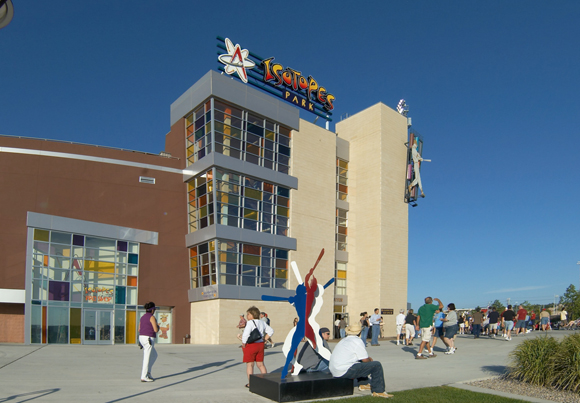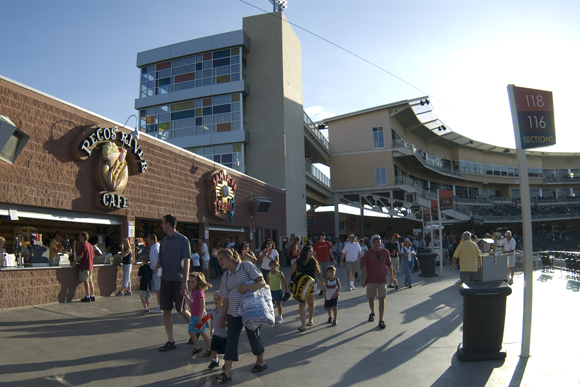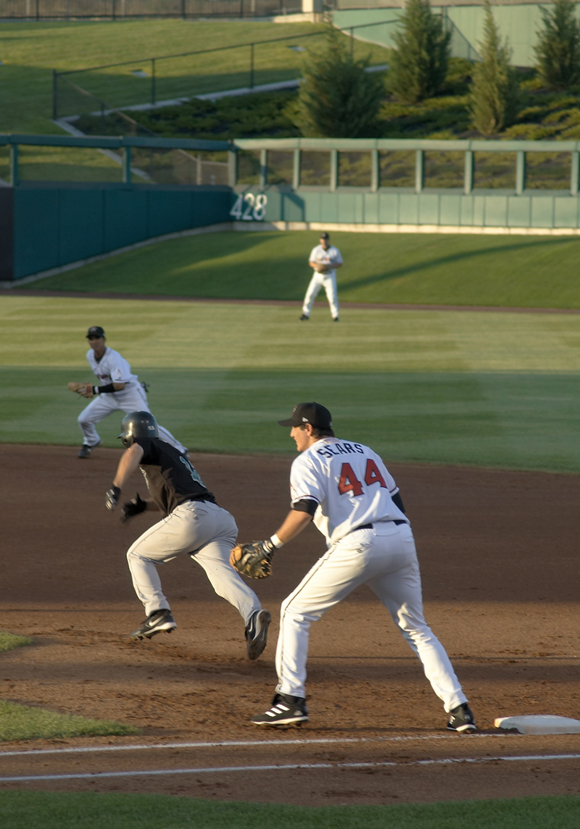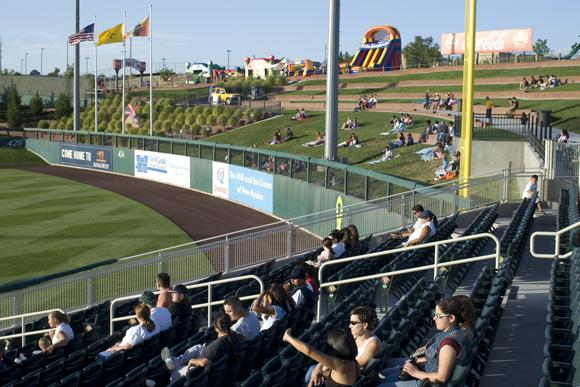Isotopes Park, the home of the Albuquerque Isotopes, is a retro ballpark, but it’s not retro in terms of brick and steel. Instead, Isotopes Park takes design cues from the 1940s and 1950s architecture found throughout Albuquerque and integrates them into a ballpark setting. Yes, it’s retro in that it hearkens back to the dawn of the Nuclear Era, but it manages to evoke the era without a hint of irony or condescension — and as a result Isotopes Park is one of the best ballparks in minor-league baseball.
Fast Facts
Year Built: 2003
Capacity: 12,215
Suites: 30
Architect: Populous
Dimensions: 340L, 383LC, 428 start of hill, 400C, 404RC, 340R
Website: albuquerquebaseball.com
Phone: 505/924-2255
League: Pacific Coast League
Team Parent: Los Angeles Dodgers
Parking: As the stadium is next to The Pit and the UNM football stadium, there’s an abundance of free parking within a block of the stadium.
Address/Directions: 1601 Avenida Cesar Chavez SE., Albuquerque. This address is slightly misleading. If you get on University, which runs north and south through the length of Albuquerque, you’ll drive right by the stadium in the southeastern quadrant of the city. It’s hard to miss.
“Retro” architecture in baseball usually means a ballpark all decked out with steel beams and brick walls, designed to look like an old ballpark from the turn of the century. And while retro been the hottest trend in ballpark design since the unveiling of Oriole Park at Camden Yards in Baltimore, it’s a trend that’s grown more than a little tired.
But retro shouldn’t be limited to just steel-and-brick ballparks. In many ways, Isotopes Park, the home of the Albuquerque Isotopes, is a retro ballpark, but it’s not retro in terms of brick and steel. Instead, Isotopes Park takes design cues from the 1940s and 1950s architecture found throughout Albuquerque and integrates them into a ballpark setting. Yes, it’s retro in that it hearkens back to the dawn of the Nuclear Era, but it manages to evoke the era without a hint of irony or condescension — and as a result Isotopes Park is one of the best ballparks in minor-league baseball.
This accomplishment is even more remarkable when you consider the history of the ballpark. Technically, Isotopes Park is not a new ballpark: it’s a renovation of Albuquerque Sports ballpark, the former home of the Albuquerque Dodgers and the Albuquerque Dukes, the former Class AAA affiliate of the Los Angeles Dodgers. After the loss of the Dukes to Portland in 2000, Albuquerque city officials knew they wanted to bring back pro baseball, but the issue was whether to renovate the Sports ballpark into a baseball-only facility (in its original incarnation it also hosted high-school football) or build a new downtown ballpark. A public referendum settled the issue, and so the $25 million renovation of the Sports ballpark began.
And what a renovation job it was. According to local sportswriters, the original bowl structure is still intact, as well as the general dimensions of the ballpark and some of the service areas connecting the dugouts and the clubhouses. But in look and feel, Isotopes Park is really a brand-new ballpark.
The tone is set by the exterior of the park. Though there are several entrances to the ballpark, a first-time visitor is advised to park next door in the football-ballpark or The Pit parking lot and enter the front Broadway entrance. A new tower serves several purposes: it’s a dramatic entrance to the ballpark, it served as a nice design counterpoint to the horizontal orientation of the ballpark, it adds a whimsical touch to the ballpark (at night, the colored panels are quite striking), and it ties into other architecture found throughout Albuquerque. It’s also functional: the tower contains an elevator, service areas, access to suites and the press box, and stairs.
Once you’re in the ballpark, you’re presented with a fairly standard ballpark layout. A concourse rings the entire ballpark, with the majority of the concession stands located in the back of the grandstand. The ballpark has a seating capacity of 12,215, but the vast majority of this seating — 11,075 — is theater-style seating between the foul poles (5,845 reserved seats, 4,029 box seats, 661 club seats, and 540 suite seats). There are 30 suites at the ballpark, and the club level features its own bar and a cozy lounge area. Beyond the left-field fence is a spacious picnic area geared for groups of all sizes, and beyond the right-field fence there’s a group of picnic tables for those who like to lounge during the game, as well as a set of terraces where kids were playing throughout the game.
The playing field also has its own distinctive qualities. First off, the field is framed perfectly with mountains in the background, so anyone sitting the grandstand will see a gorgeous vista. There’s a 127-foot-wide, four-foot-high hill in center field that does occasionally wreak havoc with outfielders; there have been at least two inside-the-park home runs because the ball has taken some odd bounces off the curved wall and the hill. (Speaking of home runs: be prepared to see a few at a ‘Topes game. Because of the high altitude and the relatively short center-field curved fence, there are a fair amount of cheap home runs flying out of Isotopes Park.)
There are some quirks and disappointments with the ballpark, however. First, the bowl and the playing field were reoriented in such a way that there’s no room for every player to sit in the bullpen (in fact, the edge of the bullpens are right on the foul lines), so bullpen pitchers and catchers must sit in the dugout until it’s time to warm up. Secondly, the ends of the dugouts are open, and Isotopes players are not pleased about such easy access for fans, who will frequently poke their head into the dugout to ask for an autograph during the course of a game. The biggest disappointment really has nothing to do with the design, but rather with a decision made by Isotopes management. The old Sports ballpark was known for its drive-in terrace, where fans could watch a game from the comfort of their car, a la a drive-in theater. A drive-in terrace was built into the new ballpark (you can see it on the photos page), but because of security concerns the Isotopes management never opened it up to vehicles. At the game I walked around the ballpark with some local sportswriters and Ken Young, the president of the Isotopes, and he indicated that there were no plans to ever open up the terrace to vehicles and that at some point it would probably be converted to a childrens’ play area.
This sounds like a cliche, but there are very few bad seats in the house, and the spacious nature of the ballpark means that a large crowd doesn’t clog concessions or restrooms. There was a crowd of almost 10,000 during my visit, but the concourse was never crammed: between the folks hanging out in the picnic areas and walking throughout the ballpark, the crowd was dispersed enough to make it seem like a crowd of half the site. On a really crowded day you might be forced to buy tickets for a set of right-field seats past the foul pole, but even these seats aren’t bad, as they’re angled directly toward home plate.
In the end, Isotopes Park is an impressive accomplishment and a ballpark on par with other superior Class AAA facilities. If it were located in a larger market — say, Sacramento or Memphis — it would be hailed as one of the best ballparks in the minor leagues. But most Isotopes fans don’t really care about such comparisons: Albuquerque seems like a pretty self-contained city, and as long as the local fans are happy with such a great ballpark, that’s all that really matters.









